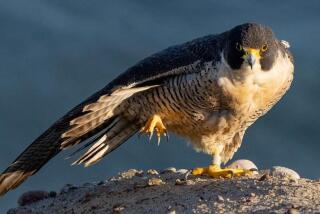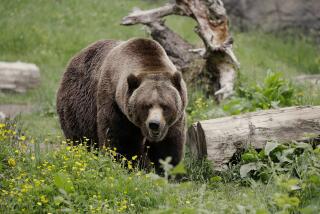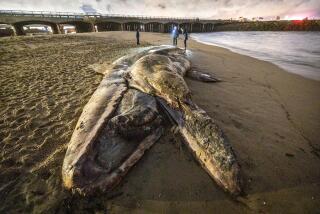Researchers find gray wolf-grizzly bear link in Yellowstone
Reintroduction of the gray wolf to Yellowstone National Park has boosted an important food source for the threatened grizzly bear, researchers have found in an example of how the return of a top predator can have far-reaching ecological effects.
A study published this week in the Journal of Animal Ecology is essentially a tale of who eats what.
When wolves returned to the park in 1995 after a 70-year absence, they preyed on elk herds that browsed on trees and shrubs.
The elk population, which had exploded without the wolves, dropped. The over-browsed plants began to rebound, including berry-producing shrubs that provide nutritious summer meals for grizzlies when they are fattening up for hibernation.
âThe grizzly bear uses some of the same plants that the prey of the wolf uses,â said William Ripple, an Oregon State University professor of forest ecosystems and lead author of the study. âThe reintroduction of one top predator is potentially affecting another top predator through this food web.â
Ripple and his fellow researchers at OSU and Washington State University compared the frequency of fruit found in grizzly bear scat to elk numbers before and after the wolf reintroduction. Over a 19-year period, they found that the average proportion of fruit in grizzly scat rose significantly after wolves returned to Yellowstone and the elk population fell.
The scientists examined and rejected other possible explanations for the smaller, pre-wolf proportion of fruit in grizzly diets, such as climate influences or the operation of open-pit garbage dumps that served as bear mess halls before the last one was closed in 1970.
Previous research by Ripple and colleagues has demonstrated other ways in which the gray wolfâs return has had a cascading effect in the Greater Yellowstone Ecosystem, the wildest in the lower 48 states.
Rippleâs work was the first to show that aspens declined after wolves were eliminated from the park in the 1920s. When wolves returned and drove down the elk numbers, scientists saw a resurgence of aspen, cottonwood and willows in some parts of the park that has in turn led to an increase in beavers.
âWeâre in the early stages of this ecosystem recovery,â Ripple said. âThis is what we call passive restoration. We put the wolf back in and then we let nature take its course.â
In the case of the grizzly, the paperâs authors said increasing berry production could help make up for the loss of whitebark pine nuts, another bear food that is threatened by climate change.
The Yellowstone regionâs whitebark pines have been dying en masse, the victim of beetle kills promoted in part by milder winters. Wildlife biologists worry that the diminishing nut crop could hurt grizzly survival.
Frank van Manen, a federal wildlife biologist and leader of the Interagency Grizzly Bear Study Team for the Greater Yellowstone Ecosystem, said that Rippleâs study was intriguing but that experiments were needed to prove the wolf-bear connection.
âI look at this as more of a hypothesis rather than an established cause and effect,â said van Manen, adding that his team has found that bears ate a lot of berries in some years before the wolfâs return.
âThereâs no real scientific consensus yet about a lot of these cascading effects,â he said. âIf we really want to answer some of these questions about ecological cascades, weâre going to have to set up some pretty intensive and broad-scale experiments.â
ALSO:
Scientists find microbes thriving on plastic marine debris
âDuelingâ dinosaur skeletons could fetch $9 million at auction
Magma can take âhighway from hellâ to fuel volcanic eruptions
More to Read
Sign up for Essential California
The most important California stories and recommendations in your inbox every morning.
You may occasionally receive promotional content from the Los Angeles Times.











